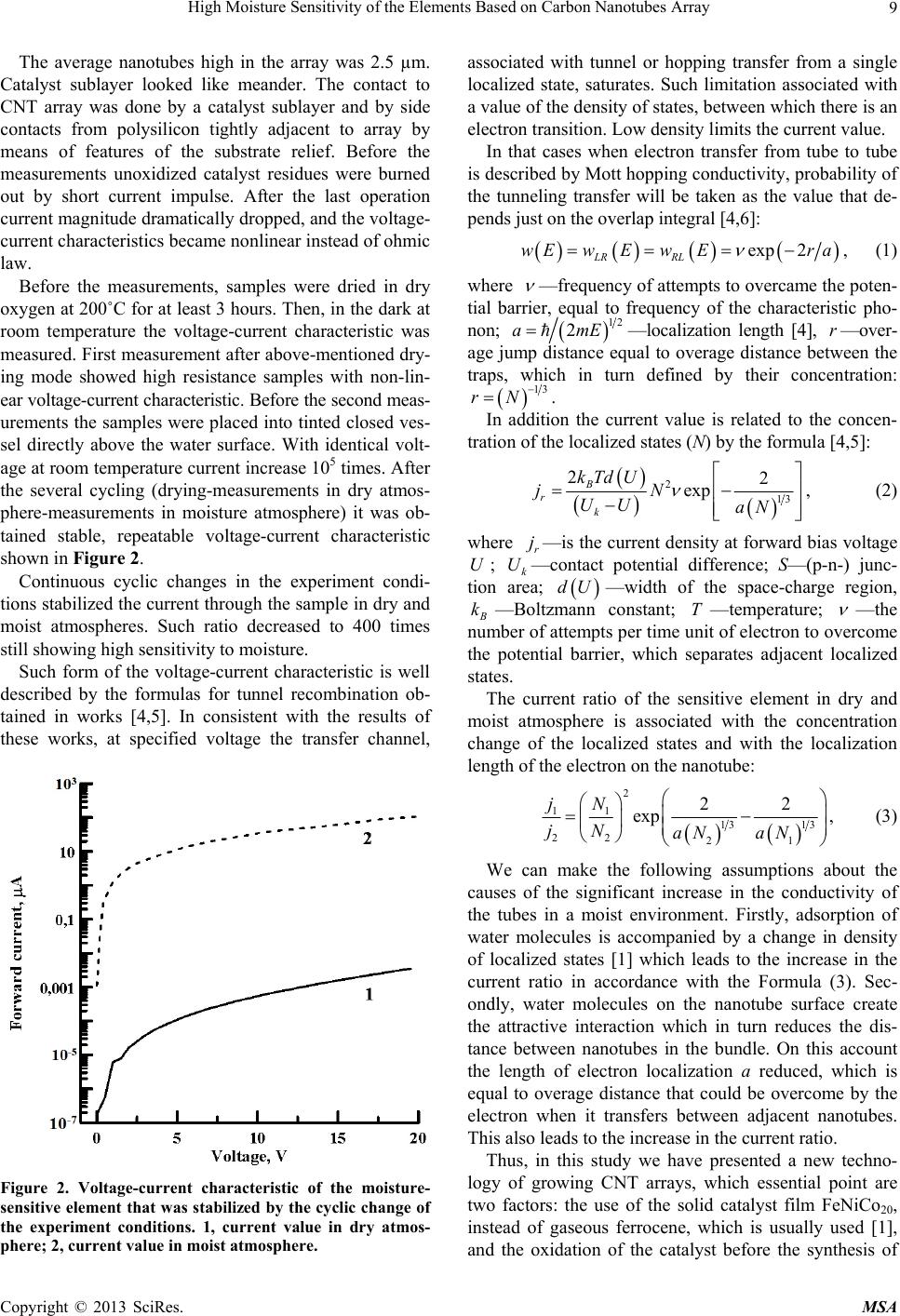
High Moisture Sensitivity of the Elements Based on Carbon Nanotubes Array 9
The average nanotubes high in the array was 2.5 µm.
Catalyst sublayer looked like meander. The contact to
CNT array was done by a catalyst sublayer and by side
contacts from polysilicon tightly adjacent to array by
means of features of the substrate relief. Before the
measurements unoxidized catalyst residues were burned
out by short current impulse. After the last operation
current magnitude dramatically dropped, and the voltage-
current characteristics became nonlinear instead of ohmic
law.
Before the measurements, samples were dried in dry
oxygen at 200˚С for at least 3 hours. Then, in the dark at
room temperature the voltage-current characteristic was
measured. First measurement after above-mentioned dry-
ing mode showed high resistance samples with non-lin-
ear voltage-current characteristic. Before the second meas-
urements the samples were placed into tinted closed ves-
sel directly above the water surface. With identical volt-
age at room temperature current increase 105 times. After
the several cycling (drying-measurements in dry atmos-
phere-measurements in moisture atmosphere) it was ob-
tained stable, repeatable voltage-current characteristic
shown in Figure 2.
Continuous cyclic changes in the experiment condi-
tions stabilized the current through the sample in dry and
moist atmospheres. Such ratio decreased to 400 times
still showing high sensitivity to moisture.
Such form of the voltage-current characteristic is well
described by the formulas for tunnel recombination ob-
tained in works [4,5]. In consistent with the results of
these works, at specified voltage the transfer channel,
Figure 2. Voltage-current characteristic of the moisture-
sensitive element that was stabilized by the cyclic change of
the experiment conditions. 1, current value in dry atmos-
phere; 2, current value in moist atmosphere.
associated with tunnel or hopping transfer from a single
localized state, saturates. Such limitation associated with
a value of the density of states, between which there is an
electron transition. Low density limits the current value.
In that cases when electron transfer from tube to tube
is described by Mott hopping conductivity, probability of
the tunneling transfer will be taken as the value that de-
pends just on the overlap integral [4,6]:
exp 2
LR RL
wE wE wEra
, (1)
where
—frequency of attempts to overcame the poten-
tial barrier, equal to frequency of the characteristic pho-
non;
12
2a
mE—localization length [4], —over-
age jump distance equal to overage distance between the
traps, which in turn defined by their concentration:
r
13
rN
.
In addition the current value is related to the concen-
tration of the localized states (N) by the formula [4,5]:
2
13
22
exp
B
r
k
kTdU
jN
UU aN
, (2)
where r—is the current density at forward bias voltage
; k—contact potential difference; S—(p-n-) junc-
tion area;
j
U U
dU —width of the space-charge region,
k—Boltzmann constant; T—temperature;
—the
number of attempts per time unit of electron to overcome
the potential barrier, which separates adjacent localized
states.
The current ratio of the sensitive element in dry and
moist atmosphere is associated with the concentration
change of the localized states and with the localization
length of the electron on the nanotube:
2
11
13 13
22 21
22
exp ,
jN
jN aN aN
(3)
We can make the following assumptions about the
causes of the significant increase in the conductivity of
the tubes in a moist environment. Firstly, adsorption of
water molecules is accompanied by a change in density
of localized states [1] which leads to the increase in the
current ratio in accordance with the Formula (3). Sec-
ondly, water molecules on the nanotube surface create
the attractive interaction which in turn reduces the dis-
tance between nanotubes in the bundle. On this account
the length of electron localization а reduced, which is
equal to overage distance that could be overcome by the
electron when it transfers between adjacent nanotubes.
This also leads to the increase in the current ratio.
Thus, in this study we have presented a new techno-
logy of growing CNT arrays, which essential point are
two factors: the use of the solid catalyst film FeNiCo20,
instead of gaseous ferrocene, which is usually used [1],
and the oxidation of the catalyst before the synthesis of
Copyright © 2013 SciRes. MSA